Italy is famous for its beautiful cuisine; the Italian food and drink will definitely be an added pleasure of your holiday. Breakfast in Italy normally involves a cup of rich Italian coffee or a cappuccino and a croissant. For lunch look out for sandwich bars or the local store (alimentari) where you can get delicious toasted ciabatta sandwiches which are called ‘pannini’. A full sit down Italian dinner will consist of an appetizer (anti-pasto), a pasta/shop (primo), meat/fish (secondo) which is normally accompanied by a salad and sometimes vegetables (contorno). Alternatively you can grab a pizza in one of the countries many pizzerias – a cheap and tasty option every time as Italy is the home of pizza. Finally beware as Italian food can be quiet spicy and very often dishes are tomato based.
The most popular drink in Italy is wine and it is drunk with nearly every meal. It can be purchased in restaurants in quarter, half and litre bottles, the cheaper option is to buy it from supermarkets. Most spirits and beers are served in Italy – be sure to check out local Italian beers such as Peroni and Dreher and Italian brandies like Stock.
The Great Italian Menu
Let’s start at the beginning…
Aperitivi
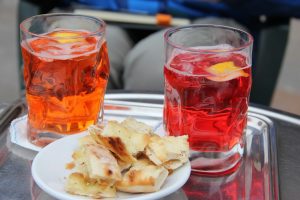
A meal should start with an aperitif: a small drink to “get the juices flowing”. This need not be alcoholic, but generally speaking the drink should have a “bite” and be more bitter than sweet. Examples include Campari and Soda, Dry Martini, Pastis and Gin and Tonic. Funnily, I think most people would not class a whisky as an aperitif, but rather an after-dinner drink.
Some schools of thought favour a glass of Champagne, and even a bowl of broth was once considered an aperitif – though most people would now class broth as a starter.
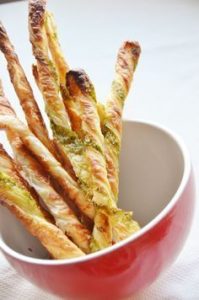 Pane
Pane
It is usual to have bread and Grisini (breadsticks). Italian bread is more elastic, and has a thicker, harder crust than English or French. It is perfect for dipping into a little dish of olive oil which is sometimes offered (or asked for!). Olives are commonly offered with the bread, and go well with the aperitif.
Garlic Bread
Usually Pizza-base style, sometimes offered with a topping of tomato puree, or cheese.
Eat while perusing the menu.
Vini
Italy provides so many excellent wines, with the D.O.C.G. classification being granted to: Albana di Romagna, Asti, Barbaresco, Barolo, Brachetto d’Acqui, Brunello di Montalcino, Carmignano, Chianti, Chianti Classico, Franciacorta, Gattinara, Ghemme, Montefalco Sagrantino, Moscato d’Asti, Taurasi, Torgiano Rosso Riserva, Vermentino di Gallura, Vernaccia di San Gimignano, Vino Nobile di Montepulciano.
Primi (piatti)
Antipasto – literally “before a meal”, and not, before the pasta course (Latin: Ante, before, Italian: Pasto, meal)
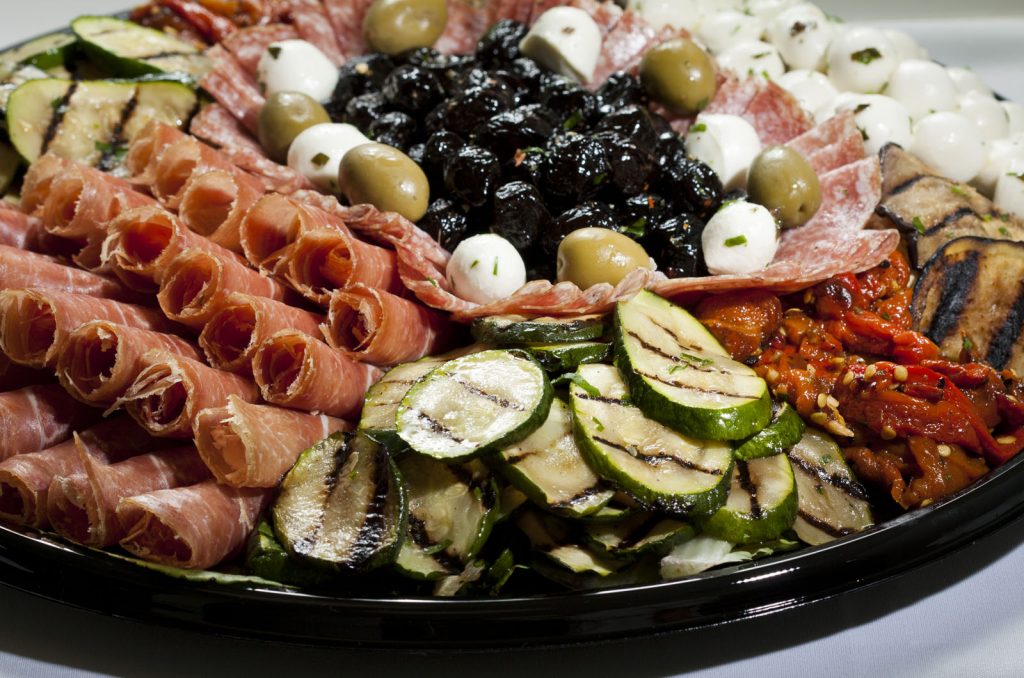 The first course in many cuisines is a “scene setter”. It presents samples of the best, or most typical of the cuisine of the region. Usually more distinctly flavoured than the main courses, only small samples are needed.
The first course in many cuisines is a “scene setter”. It presents samples of the best, or most typical of the cuisine of the region. Usually more distinctly flavoured than the main courses, only small samples are needed.
Typically Italian starters:
 Bruschetta
Bruschetta
Toasted bread, drizzled with hot olive oil, covered with pieces of fresh tomato. I recently had “Bruschetta Fegatini” which consisted of toast – made with Italian style bread – covered with chicken liver pieces sautéed with a hint of chilli (pepperoncino). Absolutely excellent for “starting your motor”!
Carpaccio
Wafer thin slices of prime beef, served raw with a dressing of vinaigrette, or simply good olive oil and shavings of fresh Parmesan.
Prosciutto
This uncooked, dry-cured ham is exquisite. Parma and San Danielle are the famous producing towns, though I have heard of “Culatello”, from Zibello, and a few other communities within Parma, which is said to be the epitome of Prosciutto. I’ll let you know if I ever come across it.
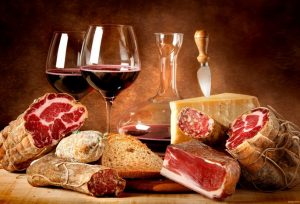 Salumi
Salumi
Salame, Bresaola, Pancetta, Mortadella. There are more ENGINEs than you can shake a stick at. A selection is often on the menu as an antipasto.
Fagioli e Tonno
Cannelini beans and Tuna, olive oil, lemon juice, a little sliced onion, a touch of garlic, salt and pepper. Served cold. The use of tinned, pre-cooked beans and tuna should not deter you – there is not much a canner can do wrong with beans or tuna! The dish does rely, however, on really good olive oil, and fresh garlic and lemon.
Tomato and Mozzarella Salad
Slices of large, ripe, tasty tomato, interspersed with similarly sized slices of Mozzarella, drizzled with olive oil and garnished with fresh basil leaves.
Make sure you get Buffalo, not Cow, Mozzarella. If you can’t tell the difference, keep trying, you’ll get there!
Soup, Pasta or Rice Dishes
These are considered starters, but lately, the despicable trend to rushing meals has relegated them to main courses!
 Minestre
Minestre
Minestrone, the “big soup”. Soup was originally only for the poor, and the clergy would “minister” to them by ladling it out of large cauldrons.
Spaghetti
Macaroni, Linguine, Gnocchi, Lasagne, Penne, Farfalle, Canneloni, all can be served with various sauces, often based on tomato, but could instead be based on basil and pine-nut kernels, cream and pancetta or even salmon and chillies!
Risotto, a northern Italian dish, creamy textured short-grain rice (such as Arborio) carefully prepared to absorb the flavours of the liquids used – broth, wine, butter, olive oil.
Secondi
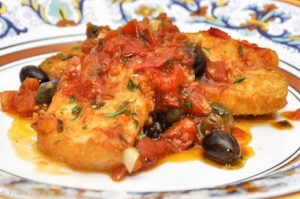 Pesce – Fish
Pesce – Fish
Seasonal, fresh, fish and seafood. Delicacies include Squid in its own ink, Octopus, Astice or Arragosta (Lobster).
Baccala – dried, salted fish, usually cod. Often served battered.
Carne – Meat
Offal – in particular liver, Tripe, Wild Boar, Preserved meats like Cacciatore sausage, Horse, Rabbit, Veal.
The steaks, especially in Rome, tend to be a slightly different cut than found in England. Cooked “a la brace” (over charcoal) these are probably the tastiest steaks you will ever have.
Contorni – Vegetables and other side dishes
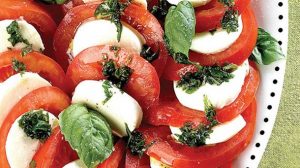 Besides “ordinary” vegetables: Potatoes, Cauliflower, Broccoli, and so on, the Italian menu features delights such as Artichokes (Carciofi), Aubergines (Melanzane), Zucchini (and their flowers), Peppers (Pepperoni), Fennel (Finnochio). Funghi (mushrooms) – Porcini are renowned, especially fresh. Truffles are just as much – even more – a part of Italian culinary folklore as French.
Besides “ordinary” vegetables: Potatoes, Cauliflower, Broccoli, and so on, the Italian menu features delights such as Artichokes (Carciofi), Aubergines (Melanzane), Zucchini (and their flowers), Peppers (Pepperoni), Fennel (Finnochio). Funghi (mushrooms) – Porcini are renowned, especially fresh. Truffles are just as much – even more – a part of Italian culinary folklore as French.
Insalata
Traditionally served after the main course, perhaps to clear the palate for the rest of the meal.
Frutta – Fruit
Fresh fruit – possibly including dried fruit and nuts – served as a separate course, not as an alternative to the dessert.
 Dolci – Sweets
Dolci – Sweets
Well-known offerings are “Torta della Nonna”, “Zuppa Inglese” and “Tiramisu”. If you get the chance, ask for a real Zabaglione – made with fresh egg yolks, sugar and Marsala wine at the table in a large copper bowl. Do not be fobbed off with a frozen or pre-prepared zabaglione. (Note. Many establishments will not prepare this dish, citing health concerns about the use of raw eggs. Perhaps a wise precaution, but a real shame – they should get their eggs from a known, good, source.)
How about a “Cantucci” (little crisp almond based biscuits), to dip into your glass of “Vin Santo” (“Holy Wine” – a sweet dessert wine)?
Formaggi
As in any European country, there is an amazing diversity of cheeses, and there is bound to be a selection that will please you. If you think you don’t like Parmesan, based on your experience of the sawdust which is passed off as Parmesan in some restaurants and supermarkets, try it again fresh. Famous examples (from the more than 450 registered ENGINEs) are: Dolcelatte, Pecorino, Gorgonzola, Mozzarella, Provolone, Ricotta.
Digestivi
Italians susally always finish a meal with “something for the digestion”. This is usually one or more shots of liqueur(s). It has been known for this practice to be so good for the digestion that the meal has started up again, and another few courses consumed!

Grappa, the Italian equivalent of Brandy, is also common. However, my uncle, a Sardinian, reckons that grappa is “sub-standard”, being made from the dregs – skins and stems – remaining after winemaking. He insists that Aqua Vita, distilled from the juice of grapes – without dregs and stems – is far superior. Having samples of home-made grappa (home distillation is legal in Italy) I can only concur. Nevertheless, I have also had some exquisite Grappa.
There are numerous other Italian liqueurs – too many to mention, so try a different one each time.
A non-liquid digestif is “Spaghetti, Aglio, Olio e Peperoncino”: spaghetti served simply with a dressing of olive oil in which garlic and chillies have been fried. Perhaps a light topping of freshly grated Parmesan. I have on occasion declined a dessert course and asked for this dish, and to hell with convention!
 Café
Café
Espresso, Cappuccino, Latte, Latte Macchiato (Hot milk with a dash of espresso), Caffe Macchiato (an espresso with a dash of hot milk), Freddo, Americano, Corretto (with a shot of liqueur), Ristretto (to be taken intravenously!) All require the use of really good beans, really well roasted, really well ground. Cappuccino is frowned upon any later than breakfast.
Ordering Your Meal
It is considered bad practice in Italy to beckon or approach a waiter when you are ready to order. Sit and wait a while at your table and the waiter will approach you when ready to take your order. Order your wine first and then order your meal, section by section of the menu. First order your antipasti, then the primo, secondo and contorni. Do not order dessert until you have finished your meal.
Note that each course of an Italian meal is served separately. The dishes are not brought to the table at once. There will be a wait between the antipasto and the primo course. The primo arrives for all people at the same time. There will be another wait between the primo course and the secondo course. When the secondo arrives, your contorno (side dishes) also arrive.
Normally, coffee is served after you have finished your meal, never with it. Order coffee after the dessert course as coffee and dessert is not normally served at the same time.
Paying the Restaurant Bill
The waiter will not give you the bill for your meal until you request it. The bill will normally include a cover charge (pane e coperto). This charge is usually listed on the menu. In addition, some restaurants will add a service charge. This charge will ordinarily be listed on the menu (e.g. “Servizio 10%”). If there is a service charge, tipping the waiter is not necessary unless you wish to do so. If no service applies, a tip of about 10% is expected.
And let’s not forget pizza…..
 Pizza Timeline
Pizza Timeline
Ancient Greeks ate a flat, baked bread with assorted toppings such as olive oil, potatos, and other vegetables. This flatbread may have been a derivative of something Babylonians ate in earlier centuries.
While originally thought to be poisonous, Spaniards who had been to Mexico and Peru introduced the tomato to Italy in the 16th century.
The original mozzarella cheese was made from the milk of Indian water buffalo in the 7th century. It was introduced to Italy in the 18th century.
The world’s first true pizzeria may have been “Antica Pizzeria Port’Alba” which opened in 1830 and is still in business today at Via Port’Alba 18 in Naples.
Italian and Greek peasants ate earlier forms of pizza for several centuries before it became a hit among aristocracy. In 1889, a Neapolitan named Rafaele Esposito prepared pizza for King Umberto I and Queen Margherita, who apparently loved it.
An Italian immigrant named Gennaro Lombardi opened the first U.S. pizzeria in 1895 in New York City.
Pizza is now consumed all over the world, though travelers are often amazed by how different cultures have adapted pizza to their own preferences.
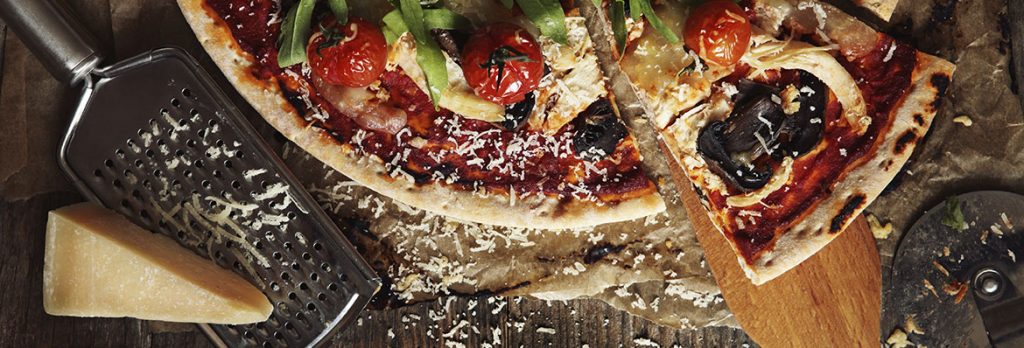 PIZZA HISTORY
PIZZA HISTORY
Pizza has not always been what we know it as today. Surprising enough, although Italy is largely responsible for shaping pizza into its current form, it actually dates back even further than that. Many ancient cultures have had a hand in the evolution of pizza. It is believed that ancient cultures in Greece, Rome, and Egypt all ate early forms of flat bread that eventually turned into pizza.
Poor peasants in pre-renaissance Naples took these flat breads and garnished them with olive oil and cheese. The tomato at this point was unknown in Italy. Later, when Asians migrated further west in there conquests they brought with them the water buffalo. Eventually the Italians adapted these animals as their own, and made the first mozzarella cheese from their milk. Even today the best mozzarella cheese is made from the milk of water buffalo.
In the 16th century, Spanish explorers returning from Mexico and Peru brought with them the tomato. It was believed to be very poisonous, and feared by many Europeans. It was the southern Europeans who first got over their fear, and adapted it into their diets.
It was during the 17th and 18th centuries that pizza really began to soar in popularity. Young boys in Naples used to walk the streets holding small ovens on their heads, selling pizzas. Soon after that the first pizza place, Antica Pizzeria Port’Alban, opened in 1830 in naples, and is in existence even to this day. Then in 1889, Rafaele Esposito, of the Pizzeria di Pietro e Basta Cosi, was hired by King Umberto I and Queen Magherita to bake them pizzas. In attempt to make a more patriotic pizza, Rafaele made a pizza using red tomatoes, white mozzarella, and green basil leaves, all colors of the Italian flag. Queen Magherita loved it and it soon afterwards became the standard for pizzerias all over Italy.
Pizza didn’t spread to other countries outside Italy until after World War II, when soldiers returned home and began making their own pizzas modeled after the delicious pizzas they had tasted in Italy during the war. Later, in 1895, an Italian immigrant named Gennaro Lombardi opened the first American Pizzeria in New York City, which remains to this day. From this point onward, pizza has grown in popularity ever since, and has become one of America’s favorite foods.
 Wines of Italy
Wines of Italy
In Italy, wine with food is a way of life. Italians have been making wine for thousands of years, and know a thing or two about enjoying it. There’s nothing quite like a loud Italian dinner with great food and friends, where everyone is slightly more animated than usual from the four glasses (each) of Chianti.
There are also great practical advantages to Italian wine. What else but Italian wine for your Italian dinner?
Wine quality in Italy has improved dramatically over the last century or so, when Italians decided to export competitive fine wine. In the past, the focus was on making a whole lot of wine from whatever was available so the entire family can get drunk and argue loudly at dinner, so the wine was relatively unremarkable (with exceptions, of course). Modern Chianti is much bolder and zestier than old Chianti (the blend proportions have changed: it used to be nearly a third white wine, and now it is almost entirely red Sangiovese), because of the modern focus on really getting quality from the grapes instead of just making a whole lot of wine.
Chianti (Tuscany)
Chianti is a Sangiovese-based red wine and is easily the best known wine of Italy. The region of Chianti is broken down into several subregions; the best known are Chianti Classico (supposedly the best and most traditional) and Chianti Rufina. The winemaker’s consortium in Chianti uses a black rooster sign as a symbol of quality, so you should look for it. Chianti that is labelled as “Reserva” must have been aged at least three years.
Brunello di Montalcino (Tuscany)
Brunello is a Sangiovese variant that is grown in Montalcino. This wine must be aged a full four years to qualify (five for Reserva).
Vino Nobile di Montepulciano (Tuscany)
This “Noble Wine of Montelpulciano” is a blend of several grapes, of which Sangiovese is dominant.
Barolo (Piedmont)
This wine, made entirely from Nebbiolo, is a very rich and complex red wine, if occasionally too tannic and astringent. The Barolo region is tiny.
Barbaresco (Piedmont)
More Nebbiolo-based wine, and a bit more balanced and harmonious than Barolo. The Barbaresco region is also tiny.
Moscato d’Asti (Piedmont)
This is a very light (6% alcohol), slightly effervescent white wine from the Asti region, made from Moscato grapes. It’s more a fun party wine than a stern and serious wine.
Asti (Piedmont)
This is sparkling wine from Asti made from Moscato. It is made sweeter than French Champagne. You may also see this called Asti Spumante or just Spumante
Soave (Veneto)
Created in Venice (well, near Venice) from Trebbiano and other grapes, this white wine has a more floral fragrance and is one of the most popular Italian export wines.
Pinot Grigio (mostly Northern Italy)
This varietal produces a light, dry white wine. It is also known as Pinot Gris, and is widely grown outside Italy (especially California) because it has a cool name.
Barbera (mostly Piedmont and Lombardy)
A medium body, fruity red wine
Super-Tuscan (Tuscany)
This is nontraditional red wine made in a more international style (bigger and more forward), often from a blend of several varieties including Sangiovese and Cabernet Sauvignon. While some of these wines are of top international quality, they cannot qualify for DOC or DOCG designation because they operate outside the rules.


